Sony Alpha 6500 User Guide

4-690-670-11(1)
Interchangeable Lens
Digital Camera
E-mount
Instruction Manual
“Help Guide” (Web manual)
Refer to “Help Guide” for in-depth instructions on the many functions of the camera.
http://rd1.sony.net/help/ilc/1640/h_zz/
ILCE-6500
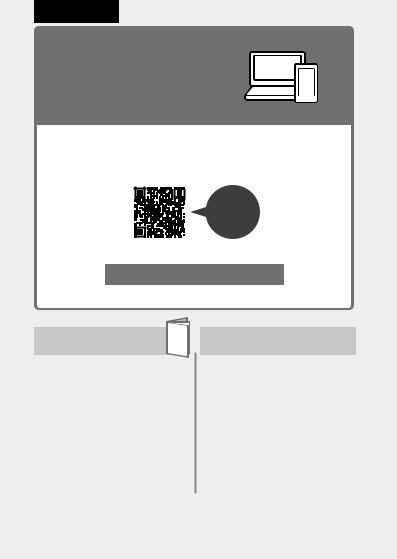
English
Check out the
Help Guide!
The “Help Guide” is an on-line manual that you can read on your computer or smartphone. Refer to it for details on menu items, advanced usage, and the latest information on the camera.
Scan here
http://rd1.sony.net/help/ilc/1640/h_zz/
ILCE-6500 Help Guide
Instruction Manual
(this book)
This manual introduces some basic functions.
For the quick start guide, see “Startup guide” (page 21). The “Startup guide” introduces the initial procedures from when you open the package until you release the shutter for the first shot.
In-Camera Guide 
The [In-Camera Guide] shows explanations of the menu items on the monitor of the camera.
You can quickly pull up information during shooting. To use the [In-Camera Guide] function, some settings must be made beforehand. For details, search “In-Camera Guide” in the Help Guide.
GB
2

Owner’s Record
Record the model and serial number (which are located on the product) in the space provided below. Refer to these numbers whenever you call your Sony dealer regarding this product.
Model No. ILCESerial No.
WARNING
To reduce fire or shock hazard, do not expose the unit to rain or moisture.
IMPORTANT SAFETY INSTRUCTIONS -SAVE THESE INSTRUCTIONS DANGER
TO REDUCE THE RISK OF FIRE OR ELECTRIC SHOCK, CAREFULLY FOLLOW THESE INSTRUCTIONS
If the shape of the plug does not fit the power outlet, use an attachment plug adaptor of the proper configuration for the power outlet.
 CAUTION
CAUTION
Battery pack
If the battery pack is mishandled, the battery pack can burst, cause a fire or even chemical burns. Observe the following cautions.
••Do not disassemble.
••Do not crush and do not expose the battery pack to any shock or force such as hammering, dropping or stepping on it.
••Do not short circuit and do not allow metal objects to come into contact with the battery terminals.
••Do not expose to high temperature above 60°C (140°F) such as in direct sunlight or in a car parked in the sun.
••Do not incinerate or dispose of in fire. ••Do not handle damaged or leaking
lithium ion batteries.
••Be sure to charge the battery pack using a genuine Sony battery charger or a device that can charge the battery pack.
••Keep the battery pack out of the reach of small children.
••Keep the battery pack dry. ••Replace only with the same or
equivalent type recommended by Sony.
••Dispose of used battery packs promptly as described in the instructions.
••Do not expose to extremely low temperatures of -20°C (-4°F) or lower or extremely low pressures of 11.6 kPa or lower.
GB
3
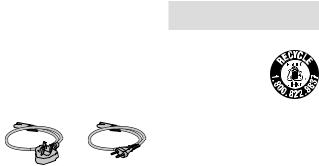
Use a nearby wall outlet (wall socket) when using the AC Adaptor/battery charger. If any malfunction occurs, disconnect the plug from the wall outlet (wall socket) immediately to disconnect from the power source. If you use the product with a charge lamp, note that the product is not disconnected from the power source even when the lamp turns off.
The power cord (mains lead), if supplied, is designed specifically for use with this equipment only, and should not be used with other electrical equipment.
Power Cord
For the customers in the UK, Ireland, Malta, Cyprus and Saudi Arabia
Use the power cord (A). For safety reasons, the power cord (B) is not intended for above countries/regions and shall therefore not be used there. For the customers in other EU countries/regions
Use the power cord (B).
(A)(B)
Notice
If static electricity or electromagnetism causes data transfer to discontinue midway (fail), restart the application or disconnect and connect the communication cable (USB, etc.) again.
This product has been tested and found compliant with the limits set out in the EMC regulation for using connection cables shorter than
3 meters (9.8 feet).
The electromagnetic fields at the specific frequencies may influence the picture and sound of this unit.
For Customers in the U.S.A. and
Canada
RECYCLING LITHIUM-ION BATTERIES
Lithium-Ion batteries
are recyclable. You can help preserve
our environment by returning your used rechargeable batteries
to the collection and recycling location nearest you.
For more information regarding recycling of rechargeable batteries, call toll free 1-800-822-8837, or visit http://www.call2recycle.org/
Caution: Do not handle damaged or leaking Lithium-Ion batteries.
GB
4

This equipment complies with FCC radiation exposure limits set forth for an uncontrolled environment and meets the FCC radio frequency (RF) Exposure Guidelines. This equipment has very low levels of RF energy that is deemed to comply without testing of specific absorption rate(SAR).
The available scientific evidence does not show that any health problems are associated with using low power wireless devices. There is no proof, however, that these low power wireless devices are absolutely safe. Low power Wireless devices emit low levels of radio frequency energy (RF) in the microwave range while being used. Whereas high levels of RF can produce health effects (by heating tissue), exposure of low-level RF that does not produce heating effects causes no known adverse health effects. Many studies of low-level
RF exposures have not found any biological effects. Some studies have suggested that some biological effects might occur, but such findings have not been confirmed by additional research. This equipment has been tested and found to comply with IC radiation exposure limits set forth for an uncontrolled environment and meets RSS-102 of the IC radio frequency (RF) Exposure rules.
For Customers in the U.S.A.
If you have any questions about this product, you may call:
Sony Customer Information Center 1-800-222-SONY (7669).
The number below is for the FCC related matters only.
Regulatory Information
Declaration of Conformity
Trade Name: SONY
Model No.: WW213019
Responsible Party: Sony Electronics
Inc.
Address: 16535 Via Esprillo, San
Diego, CA 92127 U.S.A.
Telephone No.: 858-942-2230
This device complies with Part15 of the FCC Rules. Operation is subject to the following two conditions: (1) This device may not cause harmful interference, and (2) this device must accept any interference received, including interference that may cause undesired operation.
This device complies with Part 15 of the FCC Rules. Operation is subject to the following two conditions:
(1) This device may not cause harmful interference, and (2) this device must accept any interference received, including interference that may cause undesired operation.
This equipment must not be colocated or operated in conjunction with any other antenna or transmitter.
GB
5

CAUTION
You are cautioned that any changes or modifications not expressly approved in this manual could
void your authority to operate this equipment.
Note:
This equipment has been tested and found to comply with the limits for a Class B digital device, pursuant to Part 15 of the FCC Rules.
These limits are designed to provide reasonable protection against harmful interference in a residential installation. This equipment generates, uses, and can radiate radio frequency energy and, if not installed and used in accordance with the instructions, may cause harmful interference to radio communications. However, there is no guarantee that interference will not occur in a particular installation. If this equipment does cause harmful interference to radio or television reception, which can be determined by turning the equipment off and on, the user is encouraged to try to correct the interference by one or more of the following measures: ––Reorient or relocate the receiving
antenna.
––Increase the separation between the equipment and receiver.
––Connect the equipment into an outlet on a circuit different from that to which the receiver is connected.
––Consult the dealer or an experienced radio/TV technician for help.
GB
The supplied interface cable must be used with the equipment in order to comply with the limits for a digital device pursuant to Subpart B of Part 15 of FCC Rules.
For Customers in Canada
This device complies with Industry Canada’s licence-exempt RSSs. Operation is subject to the following two conditions:
(1)This device may not cause interference; and
(2)This device must accept any interference, including interference that may cause undesired operation of the device.
CAN ICES-3 B/NMB-3 B
For Customers in Europe
Manufacturer: Sony Corporation, 1-7-1 Konan Minato-ku Tokyo, 108-0075 Japan
For EU product compliance: Sony Belgium, bijkantoor van Sony Europe Limited, Da Vincilaan 7-D1, 1935 Zaventem, Belgium
Hereby, Sony Corporation, declares that this equipment is in compliance with the essential requirements and other relevant provisions of Directive 1999/5/EC. For details, please access the following URL: http://www.compliance.sony.de/
6
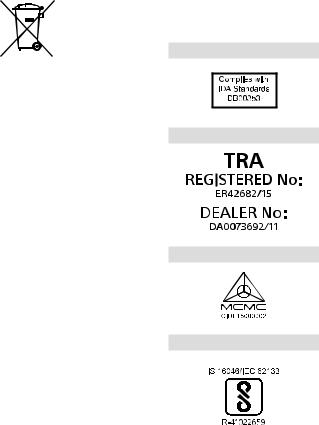
Disposal of waste batteries and electrical and electronic equipment (applicable in the European Union and other European countries with separate collection systems)
This symbol on the product, the battery or on the packaging indicates that the
product and the battery shall not
be treated as household waste. On certain batteries this symbol might be used in combination with a chemical symbol. The chemical symbols for mercury (Hg) or lead (Pb) are added if the battery contains more than 0.0005% mercury or 0.004% lead.
By ensuring these products and batteries are disposed of correctly, you will help prevent potentially negative consequences for the environment and human health which could otherwise be caused by inappropriate waste handling. The recycling of the materials will help to conserve natural resources. In case of products that for safety, performance or data integrity reasons require
a permanent connection with an incorporated battery, this battery should be replaced by qualified service staff only. To ensure that the battery and the electrical and electronic equipment will be treated properly, hand over these products at end-of-life to the applicable collection point for the recycling of electrical and electronic equipment. For all other batteries, please view the section on how to remove the
battery from the product safely. Hand the battery over to the applicable
collection point for the recycling of waste batteries.
For more detailed information about recycling of this product or battery, please contact your local Civic Office, your household waste disposal service or the shop where you purchased the product or battery.
For Customers in Singapore
For Customers in U.A.E.
For Customers in Malaysia
For Customers in India
Battery Pack
GB
7

Notes on using your camera
Along with this section, also see “Precautions” in the Help Guide (page 2).
Screen language
You can select the language displayed on the screen using the menu (page 41).
No compensation for damaged content or recording failure
Sony can provide no guarantees in the event of failure to record or
loss or damage of recorded images or audio data due to a malfunction of the camera or recording media, etc. We recommend backing up important data.
Notes on recording/playback
••Once you format the memory card, all the data recorded on the memory card will be deleted and cannot be restored. Before formatting, copy the data to a computer or other device.
••Before you start recording, make a trial recording to make sure that the camera is working correctly.
Notes on handling the product
••This camera is designed to be dust and moisture-resistant, but is not waterproof or splash-proof.
••Do not leave the camera, the supplied accessories, or memory cards within the reach of infants. They may be accidentally swallowed. If this occurs, consult a doctor immediately.
Notes on the monitor, electronic viewfinder, lens, and image sensor
••The monitor and electronic viewfinder are manufactured using extremely high-precision
technology, and over 99.99% of the pixels are operational for effective use. However, there may be some small black dots and/or bright dots (white, red, blue or green in
color) that constantly appear on the monitor and electronic viewfinder. These dots are normal due to the manufacturing process and do not affect the images in any way.
••Do not hold the camera by the monitor.
••When using the power zoom lens, be careful not to get your fingers or any other objects caught in the lens.
GB
8
••Do not leave the lens or the viewfinder exposed to a strong light source such as sunlight. Because of the lens’s condensing function, doing so may cause smoke, fire, or a malfunction inside the camera body or the lens. If you have to leave the camera exposed to a light source such as sunlight, attach the lens cap to the lens.
••When you shoot with backlighting, keep the sun sufficiently far away from the angle of view. Otherwise, the sunlight may enter the focus inside the camera and cause smoke or fire. Even if the sun is slightly away from the angle of view, it may still cause smoke or fire.
••Do not directly expose the lens to beams such as laser beams. That may damage the image sensor and cause the camera to malfunction.
••Do not look at sunlight or a strong light source through the lens when it is detached. This may result in unrecoverable damage to the eyes or cause a malfunction.
••Do not use the camera in areas where strong radio waves or radiation are being emitted. Recording and playback may not function correctly.
••Images may trail across on the screen in a cold location. This is not a malfunction.
••The recorded image may be different from the image you monitored before recording.
Notes on using lenses and accessories
It is recommended that you use Sony lenses/accessories designed to suit the characteristics of this camera. Using this camera with products from other manufacturers may affect its performance, leading to accidents
or malfunction. Sony bears no responsibility for such accidents or malfunction.
Notes on the Multi Interface Shoe
••When attaching or detaching accessories such as an external flash to the Multi Interface Shoe, first turn the power to OFF. When attaching the accessory, confirm that it is firmly fastened to the camera.
••Do not use the Multi Interface Shoe with a commercially available flash that applies voltages of 250 V or more or has the opposite polarity of the camera. It may cause a malfunction.
Notes on shooting with the viewfinder
••The image may be slightly distorted near the corners of the viewfinder. This is not a malfunction. When you want to see the full composition with all its details, you can also use the monitor.
GB
9
••If you pan the camera while looking into the viewfinder or move your eyes around, the image in the viewfinder may be distorted or the color of the image may change. This is a characteristic of the
lens or display device and is not a malfunction. When you shoot an image, we recommend that you look at the center area of the viewfinder.
••When shooting with the viewfinder, you may experience symptoms such as eyestrain, fatigue,
travel sickness, or nausea. We recommend that you take a break at regular intervals when you are shooting with the viewfinder.
In case you may feel uncomfortable, refrain from using the viewfinder until your condition recovers, and consult your doctor as necessary.
Notes on continuous shooting
During continuous shooting, the monitor or viewfinder may flash between the shooting screen and a black screen. If you keep watching the screen in this situation, you may experience uncomfortable symptoms such as feeling of unwellness. If
you experience uncomfortable symptoms, stop using the camera, and consult your doctor as necessary.
Notes on recording for long periods of time or recording 4K movies
••Depending on the camera and battery temperature, you may be unable to record movies or the power may turn off automatically to protect the camera. A message will be displayed on the screen before the power turns off or you can no longer record movies. In this case, leave the power off and wait until the camera and battery temperature goes down. If you turn on the power without letting the camera and battery cool enough, the power may turn off again
or you may be unable to record movies.
••Under high ambient temperatures, the temperature of the camera rises quickly.
••When the temperature of the camera rises, the image quality may deteriorate. It is recommended that you wait until the temperature of the camera drops before continuing to shoot.
••The surface of the camera may get warm. This is not a malfunction.
••If the same part of your skin touches the camera for a long period of time while using the camera, even if the camera does not feel hot to you, it may cause symptoms of a low-temperature burn such as redness or blistering.
GB
10

Pay special attention in the following situations and use a tripod, etc. ––When using the camera in a high-
temperature environment ––When someone with poor circulation or impaired skin sensation uses the camera
––When using the camera with the [Auto Pwr OFF Temp.] set to [High]
••Especially during 4K movie shooting, the recording time may be shorter under low temperature conditions. Warm up the battery pack or replace it with a new battery.
Notes on playing back movies on other devices
Movies recorded with this camera may not be played back correctly on other devices. Also, movies recorded with other devices may not be played back correctly on this camera.
Warning on copyright
Television programs, films, videotapes, and other materials may be copyrighted. Unauthorized recording of such materials may be contrary to the provisions of the copyright laws.
On the data specifications described in this manual
The data on performance and specifications are defined under the following conditions, except as described in this manual: at an ordinary ambient temperature of
25ºC (77°F), and using a battery pack that has been fully charged until the charge lamp has turned off.
How to turn off wireless network functions (Wi-Fi, NFC and Bluetooth function, etc.) temporarily
When you board an airplane, etc., you can turn off all wireless network functions temporarily.
Select MENU button  (Wireless)[Airplane Mode] [On].
(Wireless)[Airplane Mode] [On].
If you set [Airplane Mode] to [On], an  (airplane) mark will be displayed
(airplane) mark will be displayed
on the screen.
Notes on wireless LAN
If your camera is lost or stolen, Sony bears no responsibility for the loss or damage caused by illegal access or use of the registered access point on the camera.
Notes on security when using wireless LAN products
••Always make sure that you are using a secure wireless LAN to avoid hacking, access by malicious third parties, or other vulnerabilities.
••It is important that you set the security settings when using a wireless LAN.
••If a security problem arises because no security precautions are in place or due to any inevitable circumstances when using a wireless LAN, Sony bears no responsibility for the loss or damage.
GB
11
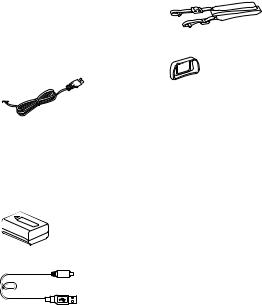
Checking the camera and the supplied items
The number in parentheses indicates the number of pieces.
••Camera (1)
••Power cord (mains lead) (1)* (supplied in some countries/ regions)
*Multiple power cords may be supplied with your camera. Use the appropriate one that matches your country/region. See page 4.
••Rechargeable battery pack NP-FW50 (1)
••Shoulder strap (1)
••Eyepiece cup (1)
••Body cap (1) (attached to the camera)
••Shoe cap (1) (attached to the camera)
••Instruction Manual (this
manual) (1)
••Wi-Fi Connection/One-touch
(NFC) Guide (1)
••Micro USB cable (1)
••AC Adaptor (1)
GB
12
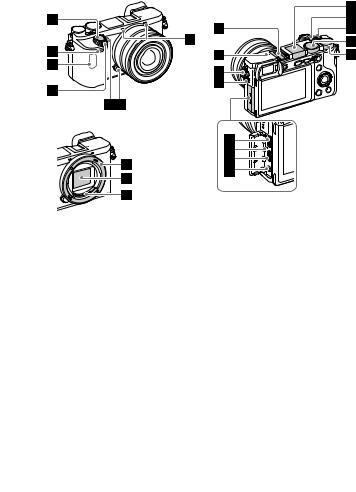
Identifying parts
When the lens is removed
Shutter buttonRemote sensor
Wi-Fi antenna (built-in)ON/OFF (Power) switch
Self-timer lamp/AF illuminatorLens release button
Microphone*Mount
Image sensor**Lens contacts**
*Do not cover this part during movie recording. Doing so may cause noise or lower the volume.
**Do not touch this part directly.
Multi Interface Shoe*
Some accessories may not go in all the way and protrude backward from the Multi interface shoe. However, when the accessory reaches the front end of the shoe, the connection is completed.
GB
13
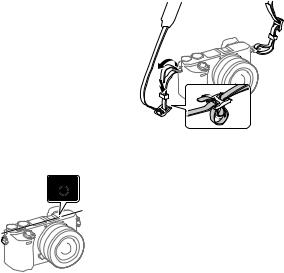
 Image sensor position mark
Image sensor position mark
The image sensor is the sensor that converts light into
an electric signal. The  mark shows the location of the image sensor. When you measure the exact distance between the camera and the subject, refer to the position of the horizontal line. The distance from the lens contact surface to the image sensor is about 18 mm (23/32 in.).
mark shows the location of the image sensor. When you measure the exact distance between the camera and the subject, refer to the position of the horizontal line. The distance from the lens contact surface to the image sensor is about 18 mm (23/32 in.).
If the subject is closer than the minimum shooting distance of the lens, the focus cannot be confirmed. Make sure you put enough distance between the subject and the camera.
Hook for shoulder strap
Attach both ends of the strap onto the camera.
GB
Speaker
Flash
••Press the (Flash pop-up) button to use the flash. The flash does not pop up automatically.
(Flash pop-up) button to use the flash. The flash does not pop up automatically.
••When not using the flash, press it back into the camera body.
C2 button (Custom button 2)C1 button (Custom button 1)
Mode dial
 (Auto Mode)/
(Auto Mode)/
 (Program Auto)/
(Program Auto)/
 (Aperture Priority)/
(Aperture Priority)/
 (Shutter Priority)/
(Shutter Priority)/
 (Manual Exposure)/ 1/2 (Memory recall)/
(Manual Exposure)/ 1/2 (Memory recall)/
 (Movie/S&Q Motion)/
(Movie/S&Q Motion)/
 (Sweep Panorama)/
(Sweep Panorama)/

 (Scene Selection)
(Scene Selection)
Control dial
You can quickly adjust the settings for each shooting mode.
14
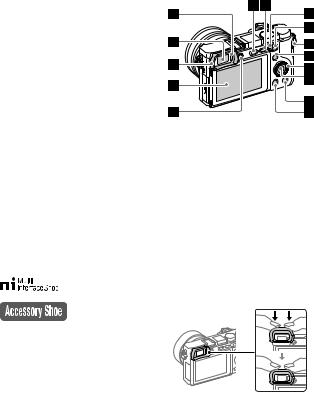
Multi/Micro USB Terminal*
This terminal supports Micro USB-compatible devices.
Charge lampHDMI micro jack
(Microphone) jack
When an external microphone is connected, the internal microphone turns off automatically. When the external microphone is a plugin-power type, the power of the microphone is supplied by the camera.
*For details on compatible accessories for the multi interface shoe and the Multi/Micro USB Terminal, visit the Sony web site, or consult your Sony dealer or local authorized Sony service facility.
Eye sensorViewfinder
Eyepiece cup
Not attached to the camera at the factory. It is recommended that you attach the eyepiece cup when you intend to use the viewfinder.
Attaching/removing the eyepiece cup
Match the eyepiece cup to the groove on the viewfinder and slide it into place.
To remove the eyepiece cup, grasp it on the left and right sides and lift it up.
••Remove the eyepiece cup when you attach an
accessory (sold separately) to the Multi Interface Shoe.
GB
15
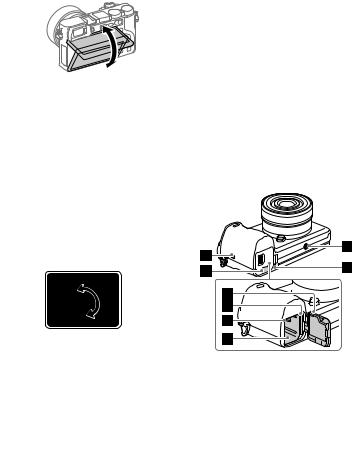
Monitor (For touch operation: Touch panel/Touch pad)
You can adjust the monitor to an easily viewable angle and shoot from any position.
You may not be able to adjust the monitor angle depending on the type of a tripod you use. In such a case, release the tripod screw once to adjust the monitor angle.
Diopter-adjustment dial
Adjust the diopter-adjustment dial according to your eyesight until the display appears clearly in the viewfinder. If it is hard to operate the diopteradjustment dial, remove the eyepiece cup before operating the dial.
For shooting: AF/MF button/AEL button
For viewing:  (Enlarge) button
(Enlarge) button
MOVIE (Movie) button
For shooting: Fn (Function) button
For viewing:
 (Send to Smartphone) button
(Send to Smartphone) button
You can display the screen for [Send to Smartphone] by pressing this button.
Control wheelCenter button
For shooting: C3 button (Custom button 3)
For viewing:  (Delete) button
(Delete) button
 (Playback) button
(Playback) button
 (Flash pop-up) buttonMENU button
(Flash pop-up) buttonMENU button
AF/MF/AEL switch lever
GB
 (N mark)
(N mark)
This mark indicates the touch point for connecting the camera and an NFC-enabled Smartphone.
16

Battery/memory card coverMemory card slot
Battery lock leverBattery insertion slot
••NFC (Near Field Communication) is an international standard of the short-range wireless communication technology.
Connection plate cover
Use this when using an AC PW20 AC Adaptor (sold separately). Insert the connection plate into the battery compartment, and then pass the cord through
the connection plate cover as shown below.
Make sure that the cord is not pinched when you close the cover.
Tripod socket hole
Use a tripod with a screw less than 5.5 mm (7/32 inches) long. Otherwise, you cannot firmly secure the camera, and damage to the camera may occur.
Access lamp
GB
17
